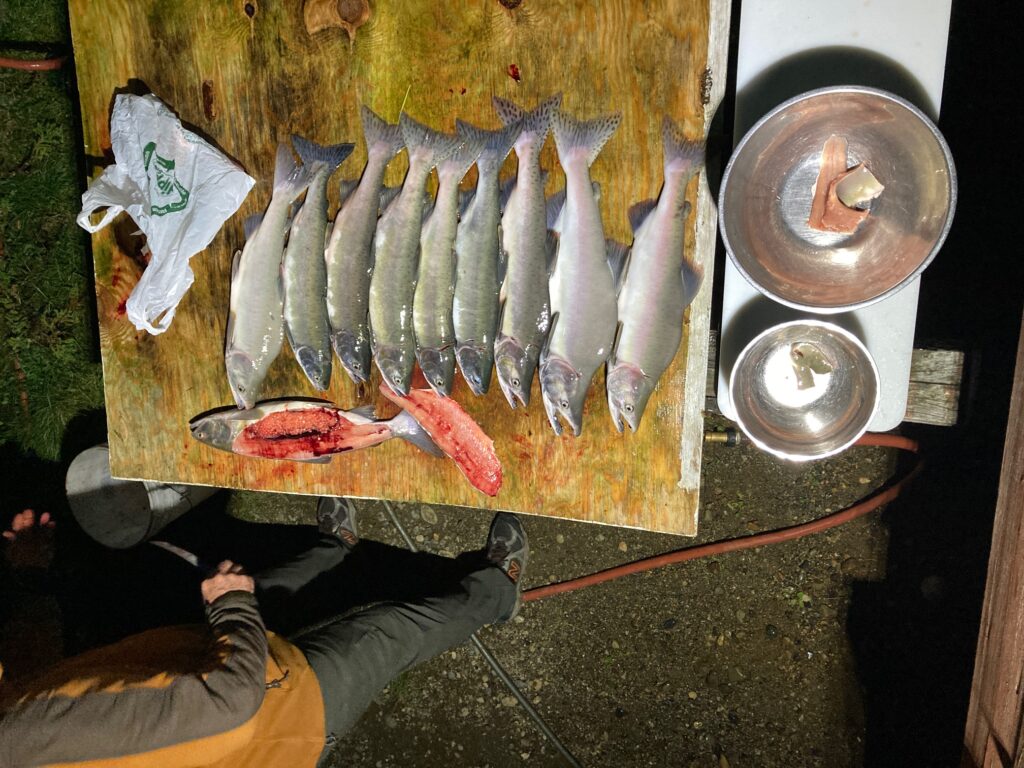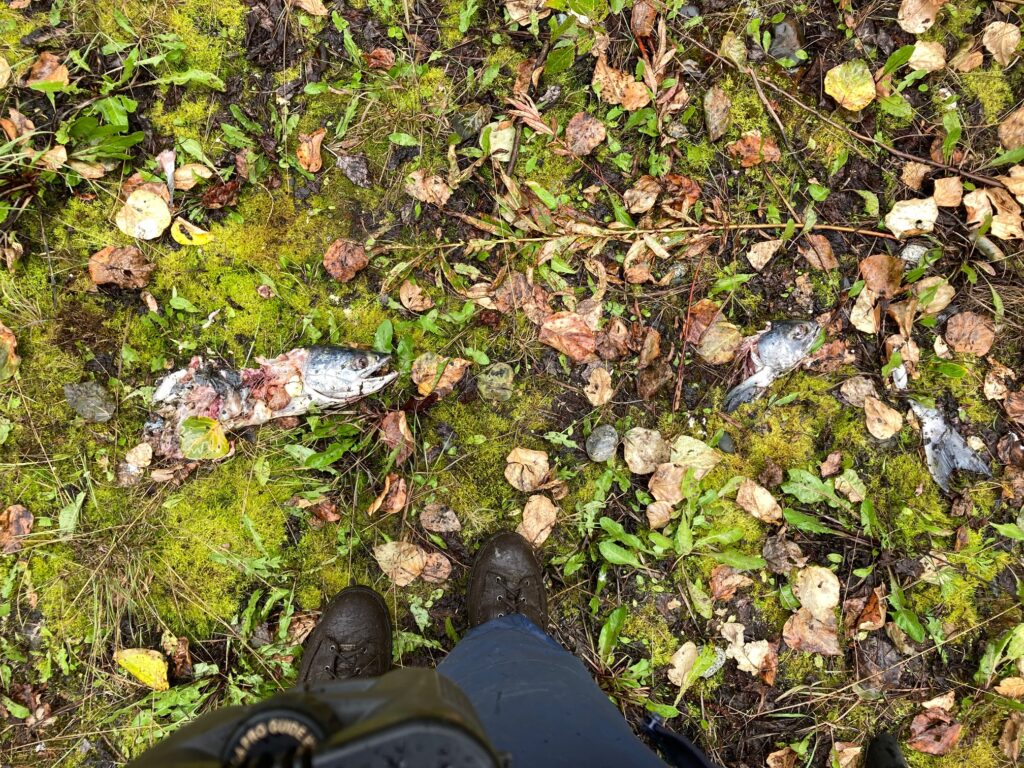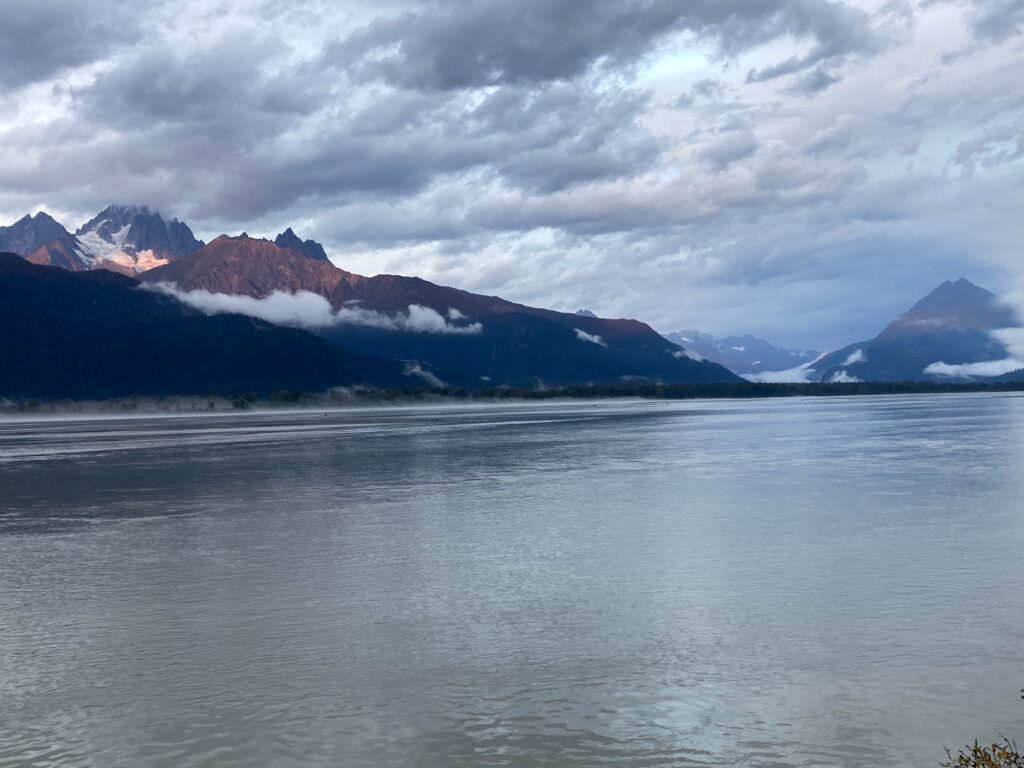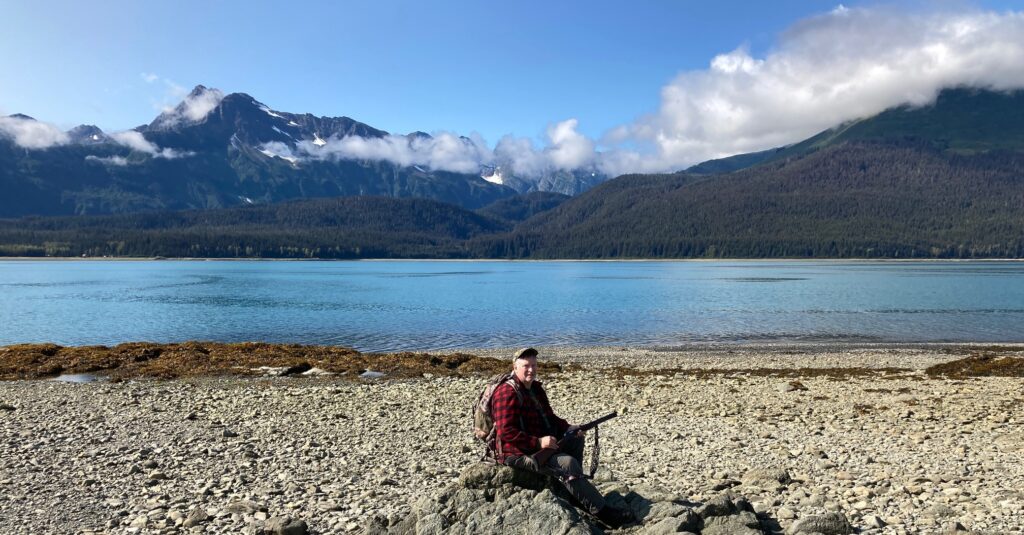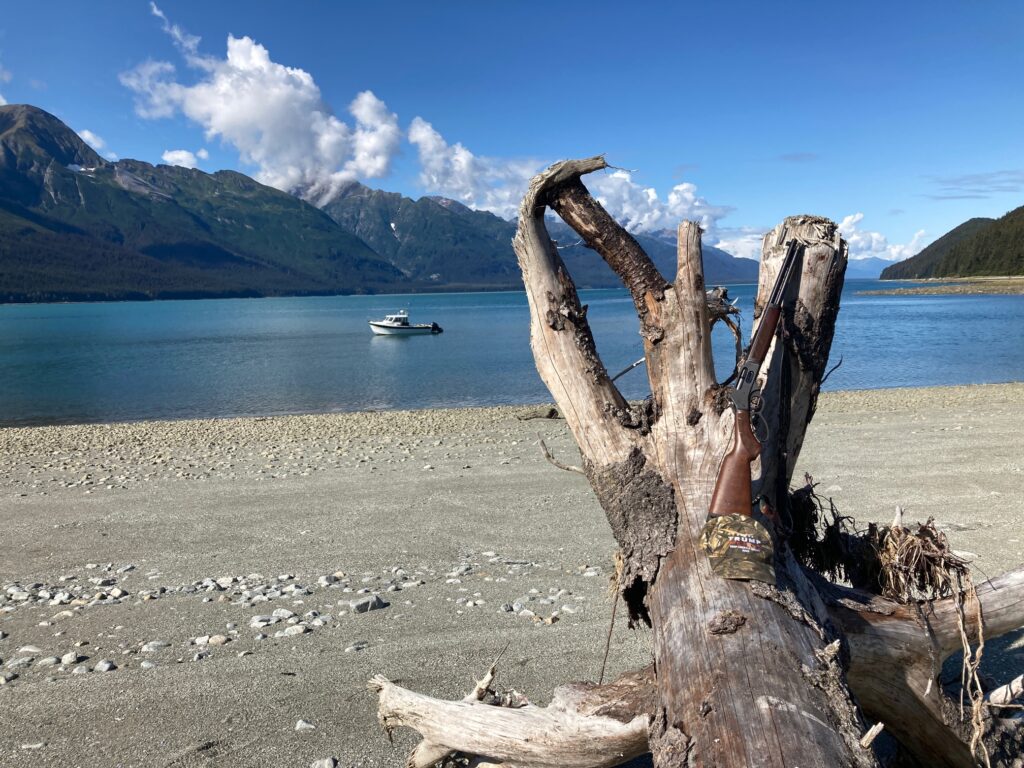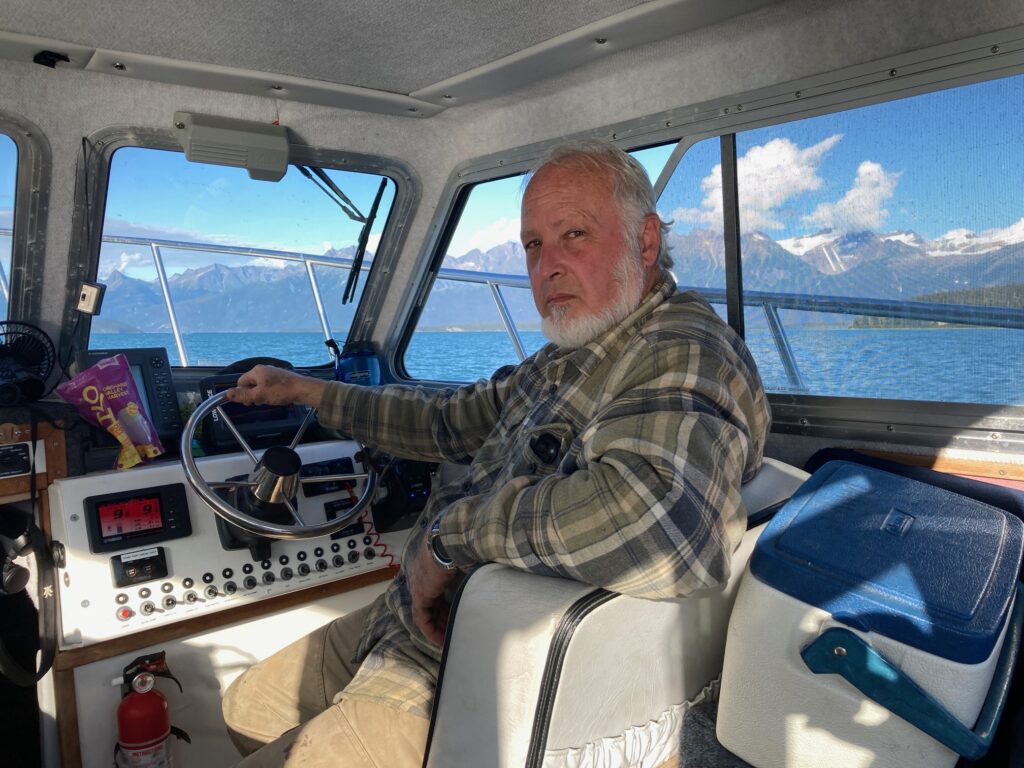Posts Tagged → fish
Great American Outdoor Show is under way
The Great American Outdoor Show is under way here in Harrisburg, PA, and I highly recommend that everyone who can visit it before it ends this weekend. It is held at the Farm Show complex between Cameron Street and MaClay Street, which is something like ten or fifteen acres of space. And this show fills that all up with vendors of every sort, visitors, lots and lots of hunting and fishing guides and outfitters (I am not really clear on what the difference is between a guide and an outfitter) from all around the world, hunting dog trials in the arena, hunting how-to demonstrations, calling contests, etc.
Archery, modern firearms from cheap utilitarian to high-end-more-expensive-than-your-car, black powder firearms, knives (t-o-o-o-ns of knives, especially Pakistani-made Damascus blades), survival gear, pickup trucks (Dodge Ram appeared with a huge array of trucks this year), ATVs and UTVs, tractors, rifle slings, handgun holsters, body armor and related “tactical” stuff (some day I am going to explore exactly what “tactical means, because like the vague and abused term “bushcraft” it can mean a lot of different things), dog cages, recreational boats, tons of camouflage clothing, cowboy boots, wool socks, travel trailers (there are some real neat new additions to the sort of “survivalist” doomsday trailer genre), especially the “OverLand” style kit, which turns a pickup truck into a Swiss Army knife of travel comforts neatly packed into a tidy package, log homes, log furniture and cabin decor, wild game cooking classes…I know I am forgetting something.
And in case you have not read this fact before, I am the guy who started the 2013 boycott of the old Reed Exhibitions show, which predated this current show. It started in response to their sudden demand that vendors not display AR15 platform rifles, because of the 2012 Sandy Hook school shooting. Our boycott led to the failure of the longstanding Reed show in 2013, which then was taken up by the NRA in 2014. The rest is happy history.
If you do an internet search on this subject, you will find some articles where I was interviewed. My favorite line from those interviews was “The British did not understand us Americans in 1776, and they still don’t understand us in 2012.”
We are in 2025 now, twelve or thirteen years later, and based on things that many British politicians and police are saying about extraditing Americans violating their speech laws, it sure seems the British still do not understand or respect Americans.
If you enjoy any kind of hands-on outdoor recreation, namely hunting, fishing, camping, hiking, boating, then this show is definitely for you. The entrance fee is $15.00 per person per day, although there are probably various discounts and bulk purchases that I do not understand. They are out there if you look.
And if anyone sees famous political activist Scott Presler there, please call me. I am a pathetic groupie of his, and I spent all yesterday looking for Scott, like a lost and sad little puppy. He said he would be at the Great American Outdoor Show…
Why do people trespass on private property?
During one of his many temporary incarcerations, infamous bank robber John Dillinger was asked by a news reporter why he robbed banks, and he famously quipped “Because that’s where the money is.” Funny enough, true enough, but Dillinger eventually ended up being shot to death by both civilians and a ragtag assortment of law enforcement agents who were fed up with his lawlessness.
I have been similarly wondering: Do people, particularly hunters, trespass on private property because that is where the wild game is? Or is there some other reason that turns otherwise normal people into lawless jerks who instigate their victims into acts of violent retaliatory fury?
My observation and experience is hunters, in particular, trespass on posted private land, and end up poaching wildlife there, because they are drawn to the mystery and promise of new territory. They think that a plot of private land that is carefully cultivated wildlife habitat must have some really nice, abundant, maybe even trophy wildlife on it. And sometimes these outlaws do, in fact, stumble into a kind of bank vault of wildlife, where they feel like they have hit the jackpot.
The problem with trespassing on posted private hunting land is that someone else, the landowner or a club that leases from the owner, has probably spent a lot of time and resources maintaining that land. Paying the real estate taxes on it, managing it, making it a sanctuary or haven for wildlife. All year long that landowner runs chainsaws, plants and prunes fruit trees, sprays herbicides, clears trails, plants various crops like clover that most wildlife find attractive.
These considerable efforts are done for the benefit of the landowner, his family, his friends, or for the club members who pay him for the opportunity to exclusively hunt there, in a very brief window of time. Hunting seasons are usually just a few weeks long. This investment of time and money is like any other investment, say, a savings account at your local bank. Or your retirement pension.
Trespassing and poaching are not victimless crimes. A landowner’s entire year’s work can go out the window from it.
Trespassers enter into the private property and, purposefully or by mistake, disturb the wildlife, maybe scare it away and off the property; poachers kill the wildlife. These disruptions come at a great cost to the landowner, who for 50 prior weeks has been working hard, husbanding the land’s natural resources, and suddenly finds himself at a disadvantage when he should be reaping his just reward.
Someone else has come along and taken advantage of all his hard work and investment, someone else has claimed his reward that he was looking forward to. Most often, the trespass intrusion and poaching so greatly disturb the property’s carefully arranged balance, that the landowner gets little to nothing of what he had worked so hard to attain. And hunting seasons are so brief that there is no time to wait out the disturbance.
This is exactly how both trespassing and poaching are forms of theft. Thievery. Scumbag-ness. Dirtball-ness. A-hole-ness. And when someone has stolen something from the landowner, the landowner can get angry about it. Sometimes really, really angry. Especially if the thief acts like the whole thing is no big deal. Because it is a really big deal to screw a landowner over and steal away from him his hard work and promise of success.
Confession time: I have been a scary person when encountering trespassers and poachers (scary to them and often to me). Not long ago a warden asked me to consider becoming a deputy warden, and I responded that I could not do that, because I get so angry at trespassers and game thieves that it would be unbecoming to see someone in an official uniform lose their cool. Yes, I have had people charged in court, but often my hand tightly around someone’s shirt collar while they get roughly dragged off the property is enough to convince trespassers that other venues hold more promise and less danger. I don’t know if many other landowners operate this way, but I am super old school. A facility with firearms and knowledge of the law also helps build confidence when dealing with armed trespassers and poachers.
As one state trooper said to a trespasser I had roughly collared, “Yes, Josh is armed. But YOU are armed, too. Is he supposed to let you shoot him so you can make your getaway? Here is your citation, do not come back here.”
Some people trespass because they are looking for things to steal, including rare plants or animals, or to drive off wild game they don’t want the landowner to get. Others trespass so they can poach wildlife through illegal hunting. Others may simply get a jolt of excitment, or are simply curious.
Folks, trespassing and poaching are a really big deal. Some landowners make a significant income from leasing their hunting land, and poachers undermine that investment. Some landowners treasure their privacy, and seeing an armed thief skulking around their property makes them feel directly threatened. So don’t do it. Don’t think it is no big deal to slip past the No Trespassing purple paint or sign and “just take my gun for a walk” or take a Sunday drive up that posted driveway.
That walk that comes so casually to you, the trespasser, comes at someone else’s expense, even if you do not see it right then. And it could end up costing you everything. No wild game animal is worth getting in trouble over, and certainly not losing your life or mobility for.
The answer to the temptation to trespass on private land is to listen to that little voice in the back of your mind warning you not to take the chance. Go to public lands for your hunting and fishing adventures. Here in Pennsylvania, public lands are super abundant. If you don’t like sharing public lands with the general public, why then, go buy yourself a piece of land and make it your very own wildlife sanctuary.
Had the once popular John Dillinger stopped robbing banks when he made that cute quip of his, he could have easily slipped away into anonymity and comfortable living, or even into celebrity and wealthy living as a free man. But he pushed it too far, and paid the ultimate price. Like too many thieves pay every day….Guys, don’t trespass and don’t poach.
And yes, baiting is a form of poaching and wild game theft. Don’t do it.
********
UPDATE December 2, 2024: Today I was sitting on a remote hillside in Northcentral Pennsylvania, with a rifle across my knees, overlooking private land surrounded by about two million acres of public land, enjoying the snow-covered serenity. Suddenly, loud voices approaching from behind grabbed my attention. Through a normally silent piece of state forest emerged four young men, in hunter orange and preparing to drive off the piece of private land.
Looking at the leader, who was giving specific directions about how to spread out and push the deer off the private land, I turned to face all of them and asked “Did we grant you permission to hunt here?”
“I mean, we have a bunch of people down in there right now, deer hunting, and they don’t expect to have anyone walking through.”
The curse-word filled abuse heaped on me caught me off guard. Me, easily the age of the fathers of these four young men, very much their elder and merely a private landowner asking an elementary question that any landowner would ask of uninvited guests, was now the bad guy.
“Eff you” Eff this” “Eff him” “Eff that” were the nicer things said to me as the young men checked that the boundary was clearly marked and backed up and regrouped.
I do not know or understand who raises such poorly behaved and aggressive young men, but for those who are inclined to ascribe poor behavior only to people with dark skin, I am here to tell you these were four white guys. Out in the middle of the big nowhere, armed with rifles, and acting like a criminal gang. With all their anger, I wondered if one of them was going to shoot me in the back.
They had already loudly walked a half mile from their remote parking spot (that itself is a long and arduous drive to reach) through laurel-choked oak woods that normally is full of deer, as the abundant deer tracks in the deep snow attested to. What if these four “hunters” had done a silent deer drive from their vehicle out to the private land they intended to sneak on? They might have already bagged a deer. Instead, they talked so loudly, so boisterously, for so long, that I thought they much have been forest workers. Never in my life have I heard hunters this loud in the woods.
Their behavior makes no sense, unless their goal was simply to spoil the posted private land that they already know is off-limits and that they were jealous of and wanted to ruin for hunting by anyone else….
I am recovering from Alaska
To our three loyal readers, my apologies for not posting in two weeks. The reason our blog here has been quiet is I was away in Alaska, almost every day spent in remote locations with no cell or wifi, the nights spent falling asleep immediately, and I just returned a couple days ago.
Alaska tourism can be done several ways – cruise ship, fly to main city like Anchorage or Fairbanks and use tourism services to sightsee and experience, or, my preferred way, go all-in hands-on. And so I spent ten days in remote locations, hunting, fishing, and hiking, marveling at God’s creation. Fortunate am I to have a long time friend who lives there, and who has long shared my outdoor adventure interests here in PA and there in AK. While he was looking for a moose more than anything, he did have a grizzly tag in his pocket, and that is the animal “we” ended up getting.
I say “we” because we were a team, because only a fool hunts alone in grizzly country, especially around the salmon streams when the fish are running, and because it takes two large men to effectively get out and cape out a large bear after one of them gets the critter. Large here was about 600 pounds; it was trying to elude a 1200-pound monster that nearly ran me over, which is terrifying and exhilirating. It is my friend’s bear, not mine. But I was “in on the kill” as used to be said in the old days.
Despite having field dressed and butchered well over a hundred big game animals in my life, I have never before seen connective tissue between muscle and skin like on his grizzly bear. We had three custom fixed blade hunting knives, and they all went dull about 3/4 of the way through the job (my JRJ made of ATS-34 was the last to go dull and the one we both alternatively used as we closed in on finishing the job). Dull due to extremely tough hide, a thick fur filled with dirt and grit and small rocks after we winched it through the woods, and that unbelievable connective tissue that just did not want to be cut. The part of skinning a big game animal that is usually the easiest, pulling the skin off the carcass, was really challenging and tiring with this grizzly. Again, I have neither seen anything like it, nor could I have been challenged to adequately imagine the toughness of that connective tissue. No wonder these huge beasts bite the heck out of each other without showing real wounds!
While I had a black bear tag in my pocket, and wolves were on the menu, I was actually most excited to be present for my friend when he got a moose. Getting a moose out of the woods is a quintessential American wilderness experience, and the one I have not done before. A trip to AK just to eventually help your friend get his moose out of the woods is a worthwhile trip, regardless of what else one might do there. However, when the beautiful male grizzly presented itself, my friend took it. As for the black bear tag I purchased, I actually walked right up to a small black bear deeply enmeshed in a blueberry bush on a steep mountainside drowning in the roar of a nearby glacial stream’s torrential rush. I could have easily killed it, but I would not shoot a bear that small here in Pennsylvania, and so I did not shoot that bear. I think if I am going to remove a black bear from the face of the sacred Alaskan earth, it will have to be a real wall hanger. So I watched this small one duck down, try to hide, and then run like hell up the mountainside, over logs, rocks, and sticks and through devil’s club like nothing was in its way. Even the small bears are impressive.
As for the salmon fishing, I could have as many pinks as the law allows, and my friends’ freezer grew full of them and short of room they preferred to save for the silver coho salmon. And so I dutifully fished daily for the no-show coho, and felt the pang of defeat when the report came in from Juneau that the cohos were there in force, on the day I was leaving. Fishing is almost always “You should have been here yesterday” or “You should have stayed one day longer,” and this rule of thumb applies just as much to Pacific salmon species as it does to striped bass or tuna in the Atlantic.
Thanks for checking in here, friends. I had a hell of a grand trip to Alaska, got my head cleared, my lungs expanded, my blood moving, my heart pumping, my legs working again, and reveled in the this-is-oh-so-right feeling of a pack and rifle over my shoulder.
A little bit of risk is good for us sedentary Western men; it keeps us sharp, feeling alive. Combine risk with hard hunting, and you end up feeling your most alive possible. Back here in PA we have a month to go before pack-and-rifle early muzzleloader season, and then another month after that before bear and then deer seasons give us that brief but intense visit with our inner and most honest, truest paleo inside.
Pictures to come.

A 22″ grizzly skull may not sound that big by itself, but it was attached to a 600 pound body with enormous muscles and claws

We beat the weeds looking for a bull moose, only to find one standing on the highway on a return drive home

Setting up a moose stand is like setting up a deer stand back East, except the moose stand comes with grizzly bears, wolves, and moose

Stalking AK black bear habitat is a lot like being in PA black bear habitat, except AK has blueberries -and- high bush cranberries, salmon berries, tons of mountain ash berries and rosehips, while PA is lucky to have any blueberries or blackberries at all, due to our overabundant deer

A pink “humpy” salmon, probably the most prolific edible Pacific species. Back East we pay five bucks for a can containing about one quarter of this fish’s meat. I was allowed six a day.

A fine looking salmon river that you must share in close quarters with cool grizzly bears on the one side, and annoying, jostling, foolish foreign tourists on the other

Whether you harvest an animal or not, simply being in Alaska with your pack and rifle is sufficient for a complete overhaul of mindset and heart

Endless vistas of countless mountainsides, each loaded with black bears, grizzly bears, sheep, caribou, and moose. A paradise of God’s creation.
PA Game Commission changing leadership
Kind of a wildlife management wild ride here in the Keystone State, though it is tough to tell if anyone really noticed or if anyone really cared. I care. People who care about animals should care.
In just a few weeks the Pennsylvania Game Commission has gone from from a very traditional conservation leadership style and background to a new style and background we have not seen in over a hundred years. I think this is a good thing, though I am sad about how it happened.
Recall that several months ago, attorney Steve Smith was promoted from director of the PGC’s Bureau of Information to deputy director of the agency, second in command to executive director Bryan Burhans. A good choice, as Smith is the very image of the dutiful, honest, earnest, hard working, straight shooting, unemotional, careful, procedurally diligent government employee. While PGC is a long way from the colorful Wild West frontier culture it once had, it still has a shadow of a bunker mentality and insular culture that do not serve the agency, its employees, or the public, and Steve is not representative of that.
Where Bryan Burhans had worked at the American Chestnut Foundation and other iconic conservation and wildlife management groups, with direct personal contacts in the nonprofit and foundation world, Steve Smith is an attorney who just happens to hunt, fish, and trap, and of course share the wildlife and habitat conservation ethos that animates hunters, trappers, and “fisherpeople” everywhere.
A devoted family man, Smith worked in private legal practice before joining PGC’s legal staff about 16 years ago. Where Burhans carried the mail for nonprofit advocacy groups both out of PGC and in it, which is the traditional model for wildlife management agency leaders across America, Smith has been long focused on public agency nuts and bolts. Dotting I’s and crossing T’s in the shadow of big speeches and public policy debates.
There is a gigantic world of difference between these two men, Bryan and Steve; their backgrounds, personalities, and outlooks could not be more different. Again, we are going from strength to strength with the change.
Bryan Burhans gets tons and tons of credit for gently, sometimes assertively molding the PGC into a more publicly accessible, publicly responsive public agency. Unlike most of his predecessors, Bryan was not a former Game Warden. And so from his own get-go seven years ago he was less insular, less committed to the law enforcement view of all things wildlife.
Yes, if you read some news reports about Bryan’s departure a couple weeks ago, you will then read about some state lawmakers griping that the agency is still not as accessible or responsive as the PA Fish & Boat Commission. I am sure that is true, and for good reasons. But compared to where the once insular and bunker-mentality PGC was, say, ten years ago, or especially twenty-five years ago, it is light years better now. Much improved. And, gasp if you must, the PGC actually now employs women in senior positions. This may be not big news to most people, but it is a fact that wildlife agencies are notoriously hide-bound and ultra traditional, the PGC having rung the bell in this regard for a long time. Celebrated wildlife biologists like Mary Jo Casalena may work for PGC, but it is as rare as hen turkey teeth that they also then get into senior management positions.
What is interesting about Steve Smith’s elevation to executive director upon Bryan’s departure is that we are actually seeing Pennsylvania wildlife management style return back to the days of Kolbfus and Pinchot – Americans without the supposedly key wildlife science “credentials” who simply care very much about wildlife, environmental quality, and habitat, and who have the intellectual capacity and personal management skills to implement the necessary policies.
PGC’s executive director is going from an outspoken advocate (albeit occasionally for things unrelated to wildlife management) to a quiet, humble, careful, almost reticent thinker. I am lamenting Bryan’s good-bye, because he did an outsanding job, and I am also really welcoming Steve’s hello. I believe that the many passionate watchers and stakeholders of PGC will be happy with Steve’s leadership there. Of course, those hunters who demand more deer than the landscape or society can sustain will never be satisfied, and I feel sorry for those people.
Update: Long and interesting interview with new ED Steve Smith is here.
A thousand overnight tragedies
Normally, the smell of rotting fish is a signal to clean out the fridge or to leave the area you are in. It’s a universally bad smell, and no one normal wants to be around it. But it was a pervasive good sign where I happened to be standing, because it was associated with the freshly dead salmon heads and remains at my feet that had not been here the previous afternoon. A thousand individual tragedies had occurred along this stream bank overnight, as bears had picked muddy bank spots to grab spawning salmon and take them uphill where they could eat them without the fear of being ambushed by humans, or bigger bears.
We had hunted and fished along a roughly seventy mile vertical stretch of southeastern Alaska for over a week, and in addition to beginning to smell a little fishy myself, I had also saturated and possibly satiated a cavernous need inside me. It is an ever-present deep, clawing need that most wilderness seekers share, be they bikers, hikers, canoers, campers, photographers, fishers or hunters. Sorry, I am not going to quote Thoreau or Muir or Roosevelt on the tonics, joys, highs, or benefits of directly experiencing wilderness. My own wilderness pleasure is gained from simply not seeing a single other human being (except my hunting/fishing partner, when I have one) anywhere near where I am hunting or fishing. That unusual moment results in me feeling like I have better than average odds of achieving my goal, because I have the whole landscape to play without intervention.
On this trip, my “public” goal was a wolf, a blacktail deer, and/or a big black bear better than 300 pounds. Hides and skulls alone were going to come home with me. Edible meat was going directly into my buddy’s freezer. All of the many salmon I caught on the trip went into either my buddy’s smoke house, into his freezer, or into my stomach. It pleases me to report back that chum (dog) salmon directly out of the ocean taste damned good. It is also a fact that chum salmon do not keep well overnight, and that even halibut turn up their noses at it. I suppose freshly caught chum can be immediately canned, but given that there are usually better alternative salmon species to eat and can, I don’t see why a person would make this choice.
Incidentally, about those salmon: Alaska’s management of its salmon runs has been so good, so professional, so scientific, and so successful, that there is actually a glut of salmon in the streams and on the American market. Therefore, wild caught salmon prices are way down. A lot of commercial salmon boats were out netting, and the cannery we visited was in business, but with diesel fuel at about eight bucks a gallon there and salmon at eighty cents a pound, it’s hard to see how the netters will survive. But thanks to the Alaska Department of Fish & Game, the bears have plenty to eat before denning and hibernating for the long, cold Alaskan winter.
Goals are critical on a wilderness trip. Even stupidly simple ones. You have to have goals before you set out on a trip like this, or else you will wonder what the heck you were doing out there when you get back to civilization. My actual personal goal was simple: To fish and to hunt as much as I could, and this goal was easily met. On this trip, I was often able to do both hunting and fishing simultaneously: We slowly trolled salmon spoons behind the boat while glassing the shorelines for critters. A rubber dinghy towed in the backwash provided us the ship-to-shore transportation we needed. See a salmon stream that is calling your name? Go ashore and hunt it, and look for salmon-eating black bears to fill some tags; and look out for the griz. We saw a lot of griz.
Only saw wolf tracks in one very remote spot, and I passed up the one black bear I had a shot at. Only twenty feet across the salmon stream from me, he was either a genetic runt, an ancient-looking yearling, or maybe a female. Whatever kind of black bear he was, he was crabby enough to growl at me before shambling off to less crowded fishing spots. I wouldn’t shoot a bear that small in Pennsylvania, and I sure wasn’t going to fill my Alaska tag with it. Maybe I will go back for the spring bear hunt in 2024.
Despite fighting our way up into the interior of an island known to have blacktail deer, we saw none and feared the griz there more than we were willing to keep going after deer. Signs of griz were everywhere. I picked and popped high bush cranberry and high bush huckleberry while noting the increasing deer browse the farther in and higher I got. But it was a veritable jungle, and surprising a griz up here would mean my certain mauling, possibly my death, and so I decided to nicely frame my deer locking tag when I got home instead of risking life and limb to fill it. I headed back out and found Merlin asleep in the sunshine on the beach.
A loud thud on the bottom of the boat awakened me from my cramped sleeping position, and I rolled out of my sleeping bag onto the cabin floor, which was cluttered with gear and guns. Walking out onto the deck to look for the source of the thump, I saw a sea lion, a seal, and a pod of porpoises chasing salmon all around us in the early morning dimness. Mist rose from the water, and then the rosy tint of dawn’s first sunbeams lit up a nameless glacier high up in the crags across the water. I felt stoned on all this Mother Nature. Like I said, I was there just to hunt and fish, and whether or not I went home with the physically tangible results was not nearly as important as absorbing and sucking up the magic around me and filling that big, hungry, empty cavern in my soul. You just can’t have this magical experience without public lands, and some of that designated as wilderness. This, these, we had.
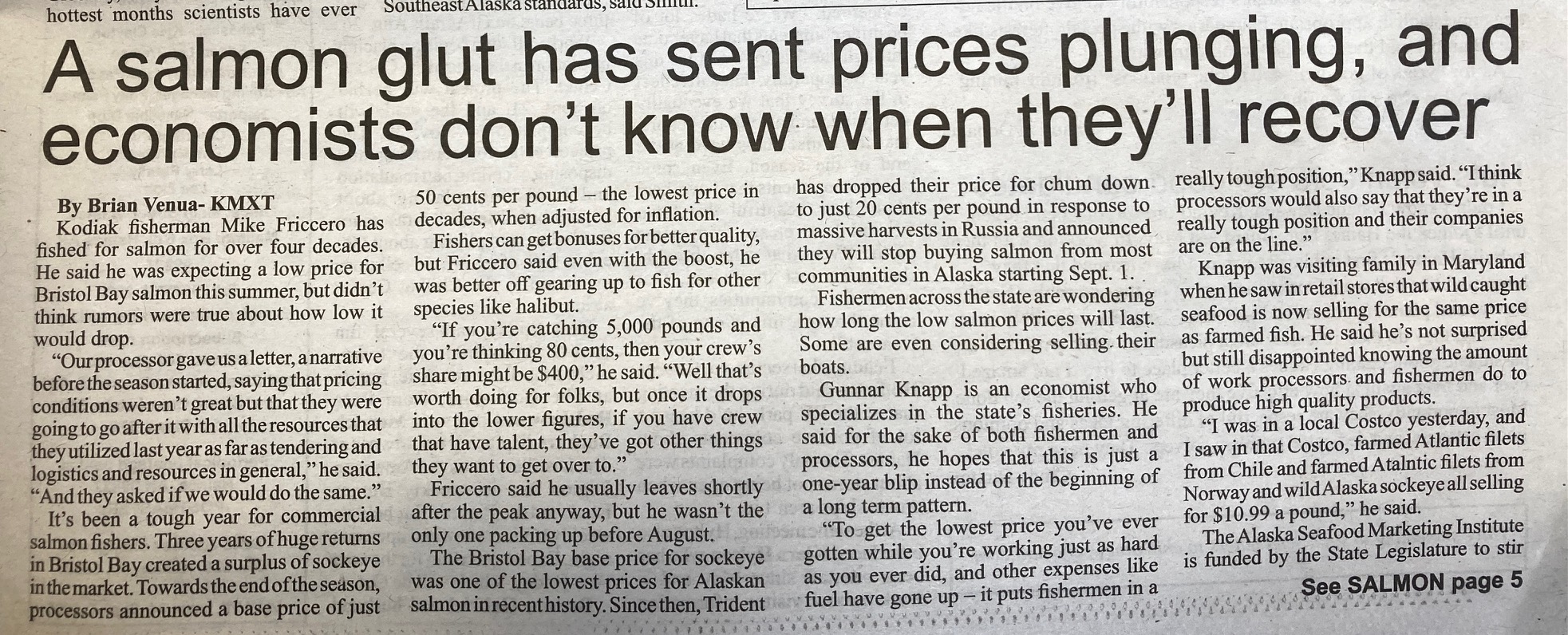
Alaskan salmon management has been so good that there are actually “too many” salmon, if there is such a thing
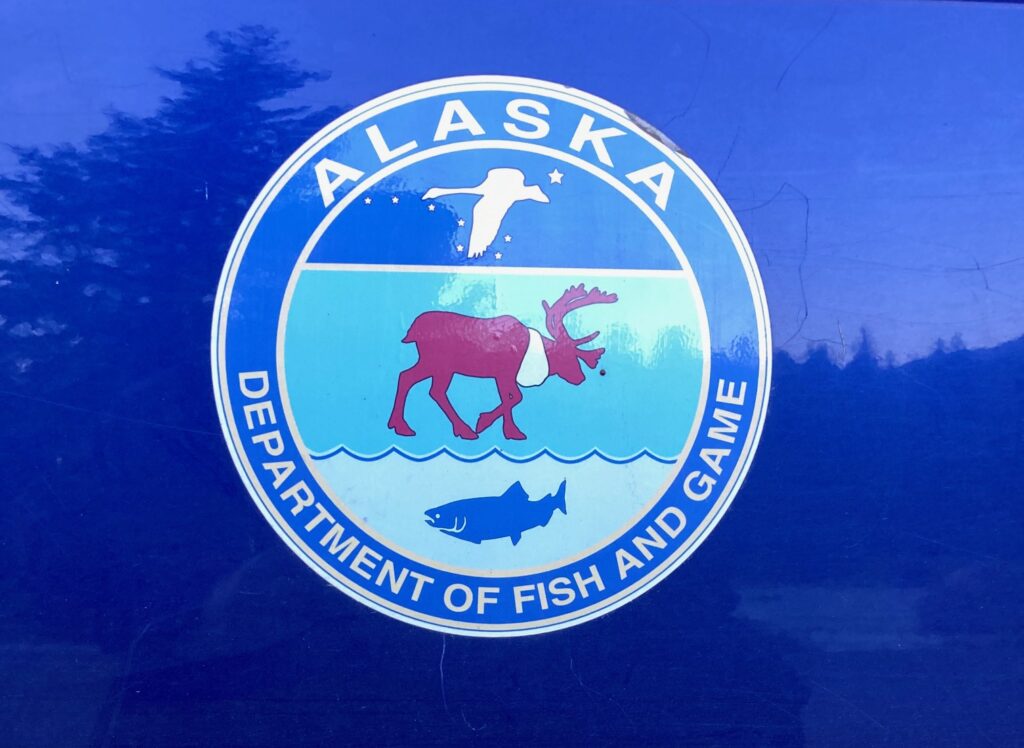
Reflected is the Chilkoot River, where we fished with the bears and a gaggle of international tourists following them up and down the river
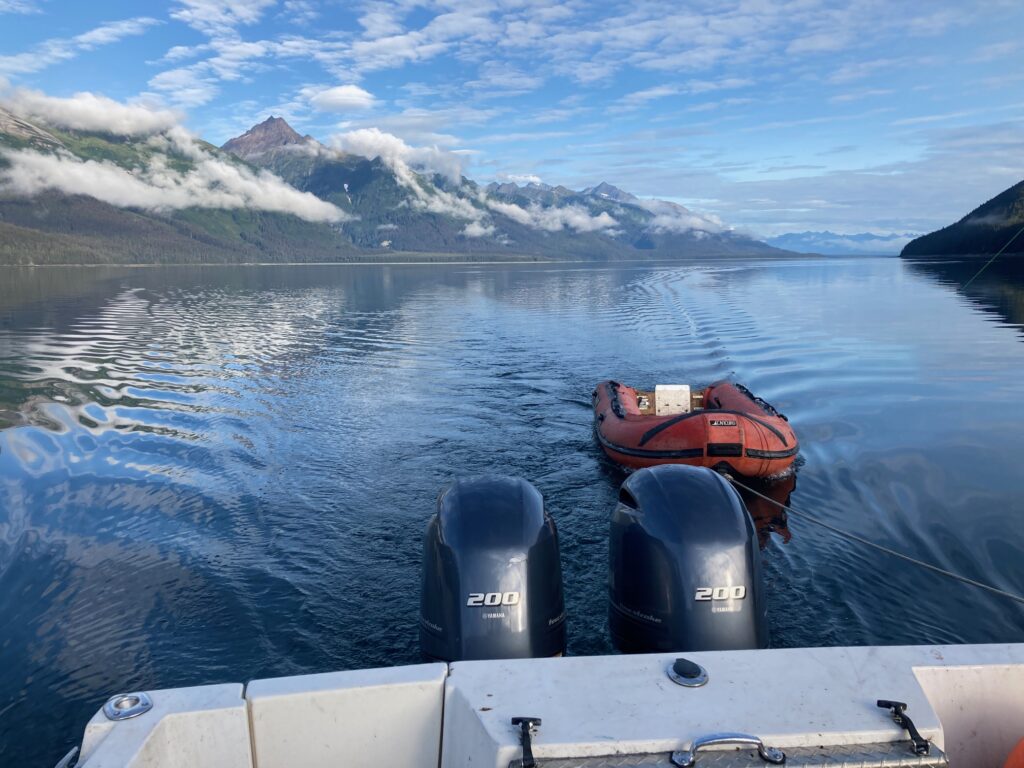
Trolling spoons for salmon, towing our dinghy, and glassing the shoreline for critters. This is hunting and fishing at the same time
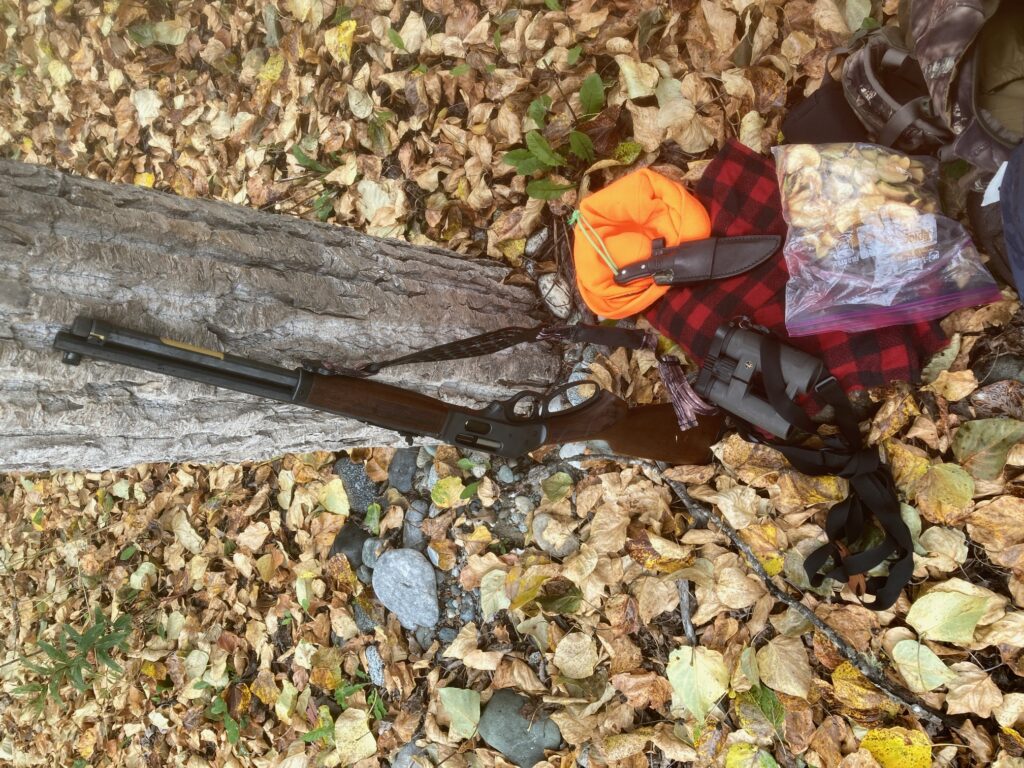
My hunting kit. A Henry 45-70 lever rifle (not crazy about the cheesy rear sight), a JRJ knife, rugged Leupold binoculars, home made dried fruit and jerky
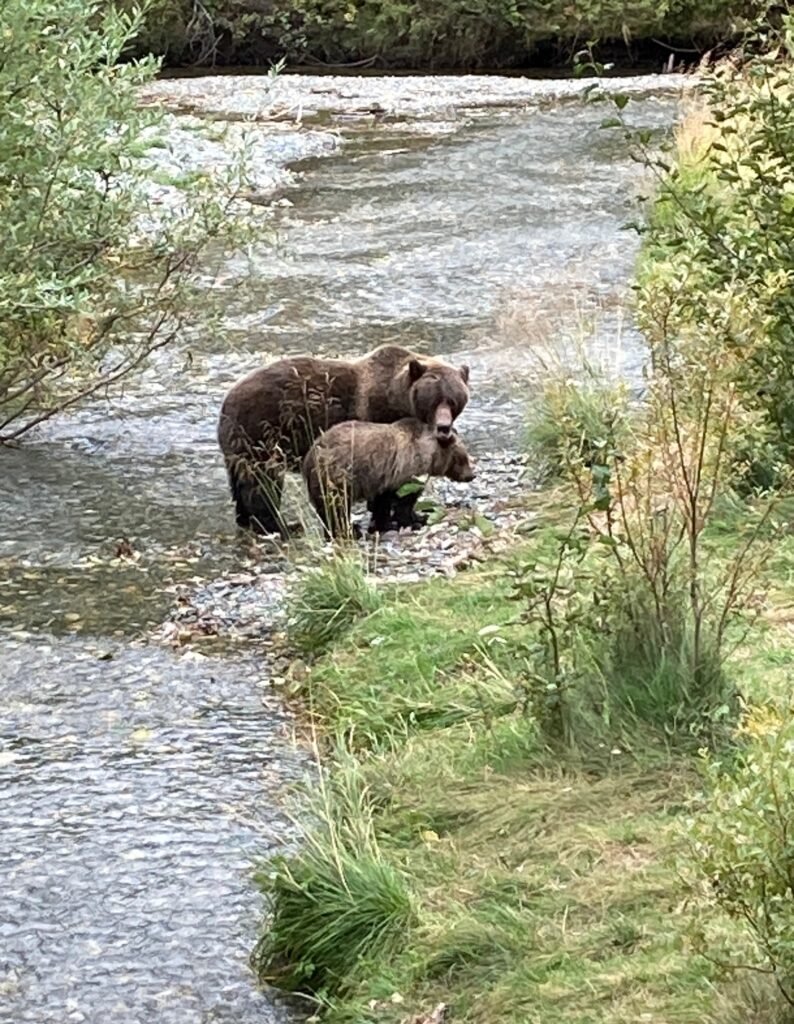
Grizzly sow and cub eating salmon as they spawn upstream from the Chilkat River. I saw a lifetime supply of griz on this trip.
There is hope: Dinosaurs on the river
One of the reasons I object so strenuously to the fake climate alarmism nonsense is that it not only takes away attention and energy from real, measurable environmental problems, it also is so transparently fake and ridiculous that more and more Americans are beginning to doubt the entire environmental quality cause with which “climate change” is unjustifiably included.
When the public is lied to for five decades, told that the climate sky is falling, and that we have only five more years until… pick your fake end-of-times flooding, crop failure, too hot, too cold, end of oil, end of natural gas etc… and those predictions do not play out, then that public becomes weary and suspicious about everything the climate alarmists say, including the very real problems like loss of farmland, forest fragmentation, invasive bugs and plants, loss of wildlife habitat, loss of wild places. And that is bad, because Americans do need to maintain environmental quality, and improve it where needed. If we lose public support for true environmental problems that have real world solutions, then we will truly and needlessly suffer in the end.
Aside from being wrong about literally everything they claim and then demand, one of the other problems with climate alarmists is that they assume and promote a view of nature as steady state. That is, Nature never changes, it is always a Garden of Eden, except for human intervention. And when humans make mistakes or act greedily, climate alarmists say massive government intervention is needed, to the point where Western Civilization must be turned on its head, democracy must be canceled (for our own good, of course), and government bureaucrats must be in charge of every choice and decision we now make (we can’t be trusted to make “the right” choice). This is yet more nonsense, for the simple reason that Nature heals itself naturally.
How else does Nature recover from natural catastrophes like explosive and polluting volcanoes, floods, huge fires, meteor strikes, tornados etc? Well, Nature abhors a vacuum, and where a gap exists in Nature, some animal and some plant will adapt to exploit it and make room to live and grow in it. Even if the prior plant or animal can no longer live there.
In 2006 something very bad and mysterious was suddenly happening to the Susquehanna River. A hard-fighting smallmouth bass fishery so good (100-200 fish per day per fisherman) that fishermen came from all around the world to fish (and spend the night and spend their money locally) from Sunbury down to the Conowingo Dam in Maryland, was suddenly gone. Vanished. And gone along with the vanished smallmouth bass were the big predacious muskellunge, brown trout from the feeder stream mouths, largemouth bass, fallfish, sunfish, redeye, and shad.
Within just a few years a highly tangible and visible environmental catastrophe had revealed itself as a long stretch of the Susquehanna River literally went belly up and died. Native aquatic insects, the backbone of all life in the water there, disappeared. Up until 2005, you could stand on a late summer afternoon in Harrisburg along the Front Street Greenbelt walk and watch as the entire river surface practically boiled with dimples from rising fish eating hatching mayflies, caddis flies, and stone flies. In 2006 that whole activity ceased. Literally everything in the river died, and it still has not come back.
Long story short, what caused the demise of the Susquehanna River was a perfect storm of every bad thing that could happen to any waterway anywhere. If it could go wrong for the Susquehanna, it did go wrong in just a few short years, and the sum total was a total unmitigated shock and detonation of the waterway.
Several years of drought and unusually warm summers led to unusually low water flows, which left fish exposed and with no where to hide from predators. The over-heated water then developed algae blooms that robbed the water of its oxygen, suffocating fish and prey crustaceans like crayfish. When large summer thunderstorms happened, they overwhelmed and drowned the many community sewage treatment plants along the river, resulting in “Combined Sewage Overflows” up and down the river. These huge torrents of raw, untreated, undecomposed human filth blasted into the low, warm river water. There was no dilution of the mess, because the river was too low and too slow. One can only imagine that the conditions then were ripe for that human excrement to sit in still waters and become a feast for bacteria, which attacked the few surviving fish and left them with open wound lesions. Then viruses appeared, apparently rejoicing in the poor conditions, further attacking the remaining fish. Finally, when Pennsylvania’s shale gas boom started in 2006, there were some documented and suspected incidents of “midnight dumping”, where large tanker trucks filled with well brine or frack water were illegally unloaded into waterways that, of course, went into the Susquehanna River.
With the demise of the river’s fish, native grasses and watercress, the birds that migrated to, lived on, and migrated down the river, had nothing to eat. They also disappeared. Hundreds of egrets and herons, and huge rafts of ducks and geese used to grace the shores and skies above the river around Harrisburg on any given summer or Fall day. Not any more.
In 2005 one of America’s largest Great Egret rookeries flourished on the islands in the Harrisburg Archipelago across from Harrisburg City. My fishing buddy Ed Weintraub and I used to wade half a mile out to fish among the archipelago’s islands, and marvel at the hundreds of these gigantic pterodactyl-looking birds and their enormous nests. The place sounded like what a Jurassic jungle must have been like, with loud screams, cries, grunts, groans, and other weird sounds from the huge birds and their babies assembled in that relatively small place. All the boulders jutting out of the river were coated in bright white bird dookie, as were the trees. The entire place stank to high heaven of rotting fish. It was a natural marvel of human-Mother Nature coexistence that reflected the incredible environmental diversity and health of the waterway, despite it being surrounded by huge train yards and human communities. This all was also eventually lost to whatever was ailing the river.
In 2011, while kayaking and wading the unnaturally smelly river in Harrisburg, I contracted MRSA in a tiny scratch on my leg, and then spent four days on a drip IV in a hospital, successfully avoiding the loss of my leg. The river was deader than a doornail and I almost joined it.
Last week two of us took a nice long canoe trip down river, my first in years, to see how the river has changed. We see a few bass fishermen now, local catfish guides brag about sixty-pounders, and walleye boats are out every day. Something in the river must be improved. It seems to be healing, but it is nowhere near where it was twenty years ago. I know that the West Branch of the Susquehanna is greatly improved from twenty years ago, when acid mine drainage turned its waters an unnatural turquoise blue. Now those old mines are washed out by the subterranean springs that first unleashed the mines’ acid, and the cold water is now clean and actually improving the West Branch.
Large bass and catfish -a more rugged critter filling the void left by the formerly numerous smallmouth bass- scurried out of our shadow, and as we approached the Harrisburg Archipelago, we began to see Great Egrets wading around the upstream islands. Lots of them. A juvenile bald eagle patrolled above. We paddled around and through the Archipelago and were surrounded by cormorants (a federally protected pest), mallards, wood ducks, turtles, a snake, and lots of nesting Great Egrets.
The dinosaurs were back on the islands and so were my hopes for a comeback by the river. No metaphysical cataclysmic environmental or political catastrophes were required for Mother Nature to bounce back. She always does, and she always will, despite what the Al Gore type fakirs predict.
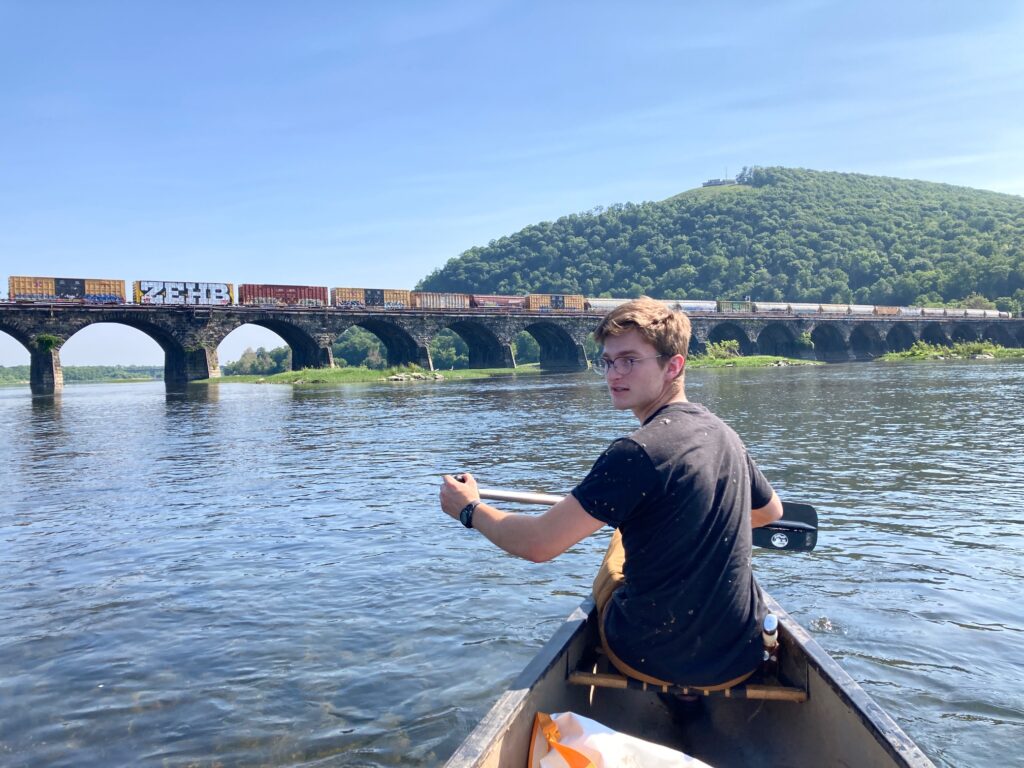
The Rockville Bridge is the longest stone arch bridge still in use in the world. I think it is longer than the Glenfinnan Viaduct in Fort William, Scotland, which I have ridden over in a train. The Susquehanna River is slowly recovering from the many things that ailed her, and is now a delight to experience.
Trump Great American Outdoors Act hits Conservation Home Run
Conservation is where I have spent my entire career, and it is where my heart resides day in and day out. So it is with great happiness that I see President Trump sign into law the Great American Outdoor Act, which will do the nuts and bolts environmental protection America needs, without the regulation that America does not need.
The fact that so many political appointees within the Trump Administration were cheerleaders for the GAOA says a lot about the political tenor there. So many people accuse the Trump Administration of being some kind of radical “right wing” blah blah, and the fact is that the entire administration is loaded with middle-of-the-road professionals, who hold a mix of political, philosophical, and ideological views. In past Republican administrations, there were plenty of appointees who would have blocked GAOA, or held it up. GAOA is a signature achievement for President Donald Trump, and it is a huge win for Americans.
GAOA fully funds the Land and Water Conservation Fund for the first time in a zillion years. It provides adequate funding for federal and state parks infrastructure updates, operations, and maintenance costs. These are the costs that are always deferred in every administration. It is a subject I wrote my master’s thesis on at Vanderbilt University, and it is a subject that has never gone away, until now: Federal recreational infrastructure has been woefully underfunded for decades. Many state parks across America are in even worse shape than that National Parks.
For example, in 2016 my teenage daughter and I hiked half of the Northville Placid Trail, which runs through the Adirondacks. At the end of our ninth day, as we waited out a looming thunderstorm in a rustic but comfortable lean-to deep inside designated wilderness, on a hike in which we had encountered only a few other people, my daughter sat looking at her dead iPhone. Like Gollum looking at The One Ring, only my daughter looked more disgusted and glum than happily mesmerized.
“I have to get out of here. I want to talk to my friends. I want to know what is happening in the world. We need to go,” she said, and picked up her backpack, jumped down onto the grass, then shouldered her backpack.
Oh, I tried to persuade her to spend the night and stay out of that coming downpour. But she would have nothing of it, and she set off by her own teenage self, going somewhere, maybe anywhere, and I was standing there watching her pick her way into the forest.
Hours later we emerged at Moose River Plains, what maps describe as a rustic New York State recreational area tucked away deep in the Adirondack wilderness. What we found was a boarded up main building, boarded up out buildings, no gate, and no official staff. Instead, a bunch of locals who regularly camp there had taken over the official duties of park rangers. Even the land line phone system was not working. It was a very kind local who drove us, each drenched to the bone and with sodden packs, to the closest village, where we could contact our driver and get back to our own vehicle parked at a Baptist church in Northville, so my daughter could get home and talk with a zillion friends simultaneously.
Turned out that Moose River Plains was victim to a New York State budget that prioritized funding illegal aliens, but not state parks.
The Moose River Plains experience was worse than our visit the year before to Saratoga National Battlefield, by far. But seeing Saratoga National Battlefield, where the brave fight for American freedom and independence was won, in such terrible disrepair and threadbare means, was frankly shocking. One expects the National Park Service to do so much better. And when we spoke with a park ranger there, she was clearly hurt, personally, as she explained the money constraints that park faced. NPS just could not get the job done.
All of this is to say that finally, money floweth in the right direction. The need out there for public infrastructure is almost beyond compute. It is about time that America invested in our national parks and forests, state parks and forests, local and county parks, and the myriad other adjunct little recreational areas, like Moose River Plains, so that Americans might enjoy our public outdoors.
And about that public outdoors thing: Public land is a public good. Public land is one of the very few things that government does pretty well. And even when government land managers fail, the outcome is almost always simple neglect; the land always remains, the wildlife habitat remains. Which means the opportunity for recreation, hunting, fishing, hiking, camping etc remains. It is not a real material loss when land managers screw up or there isn’t enough money to operate the park entrance gate house; just missed opportunities, and putting a frowny face on a public symbol.
Congratulations to President Trump for pushing hard for GAOA, for hiring the right kind of land management staff and public lands leaders, and for caring about our public lands at all levels – local, state, and federal. Trump understands Americans, and he knows how much we care about our public lands, our state parks. And he knows how important it is to constantly invest in those places, so that they don’t fall into disreputable disrepair, like Moose River Plains had fallen.
One of the parts of GAOA that is so very appealing to me is the public land acquisition funding. As development never sleeps, what were nice public spots to hunt or hike in suddenly find themselves cut off or surrounded or overrun by development. It is nice that states and local governments will finally be able to buy that ‘Mabel’s Farm’ the community always wanted, and could not afford.
There is going to be a lot of Mabel’s Farms bought with GAOA money in the next few years, a lot of Nature conserved, and a lot of communities and hunting places protected, as a result. Thank you, President Trump, conservationists everywhere appreciate your leadership on this important policy area.
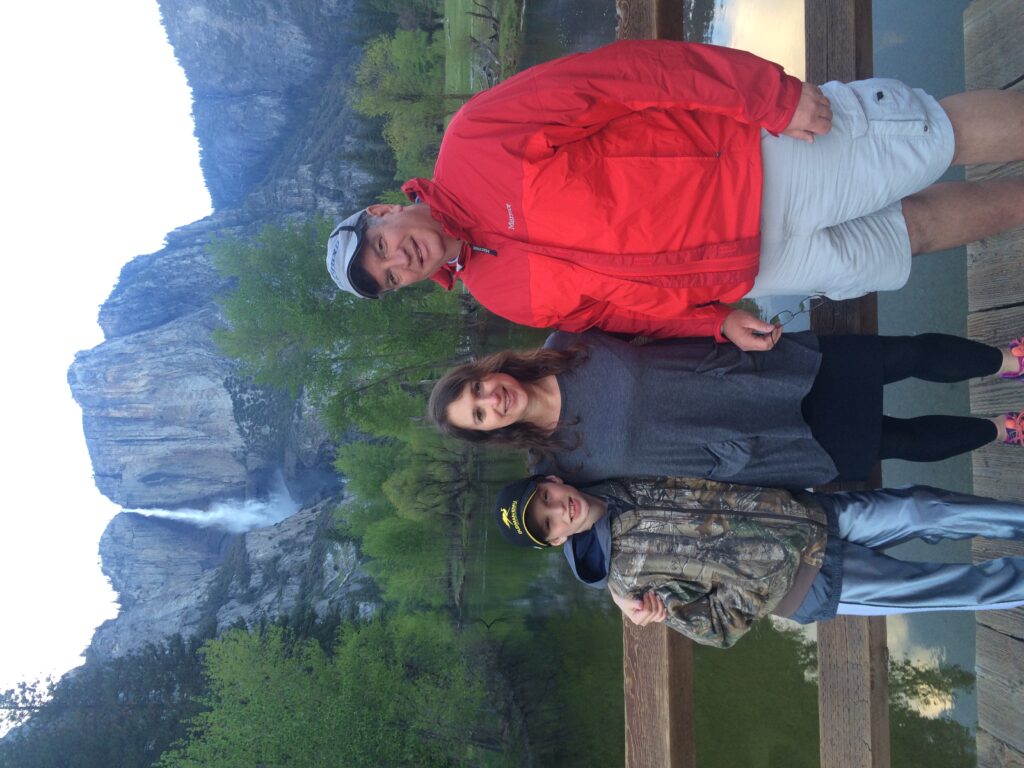
With special people at Yosemite. Can we imagine America without Yosemite? It takes money to protect these special places.
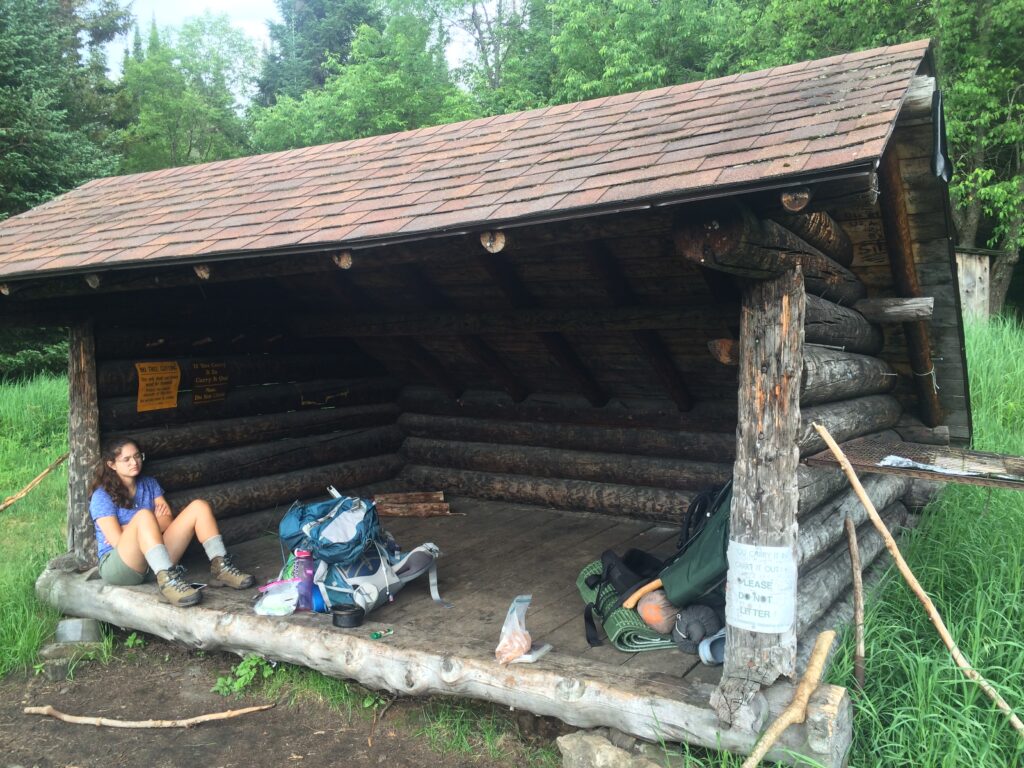
My daughter at the unhappy lean-to. But still, it was a functional, dry lean-to next to clean water in the middle of ADKs wilderness
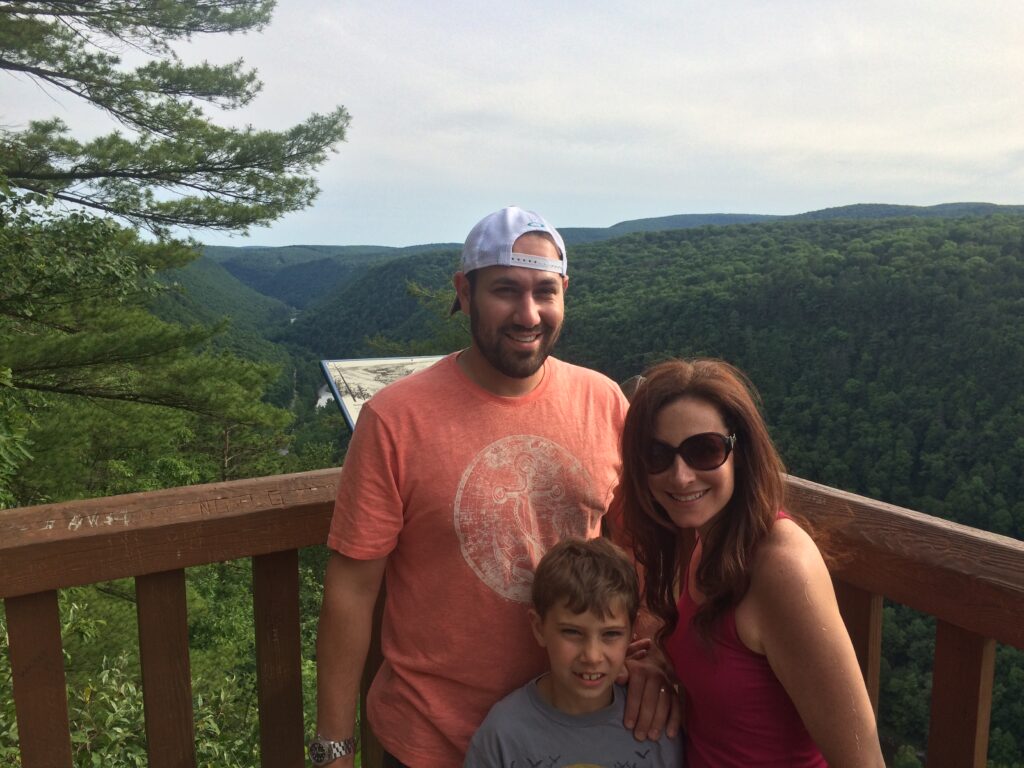
Our friends Mark and Amanda at Leonard Harrison State Park, overlooking the Pennsylvania Grand Canyon
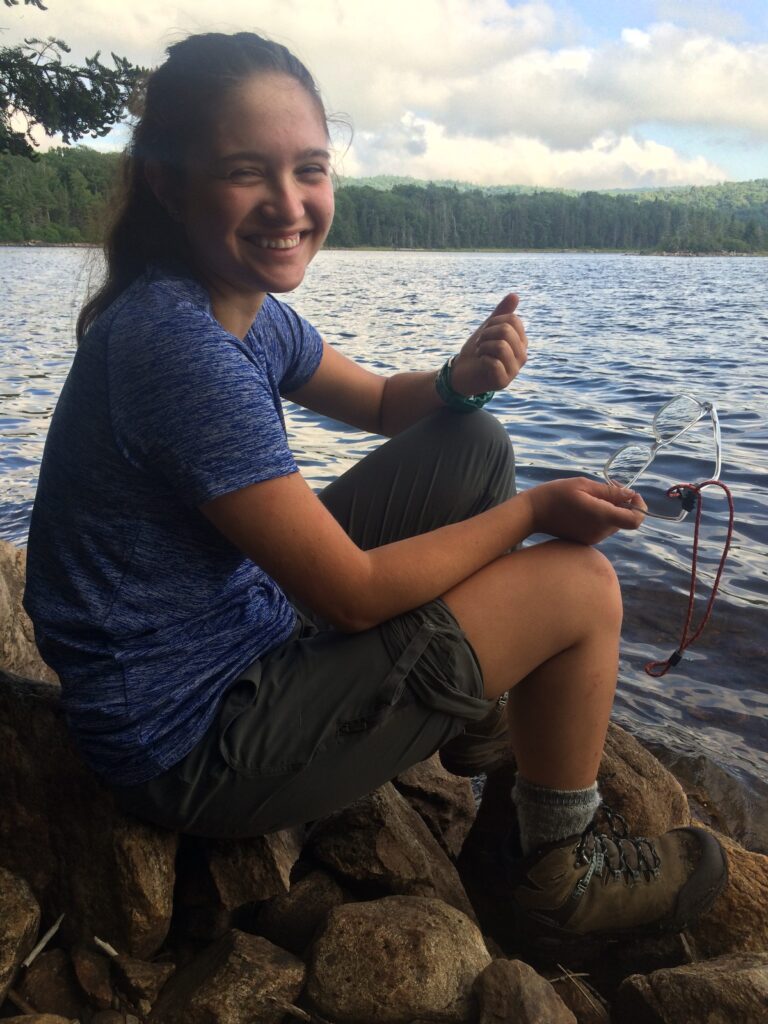
My daughter at Cedar Lakes, a special moment that spurred her on to teach wilderness backpacking to kids. Now she can’t wait to reach the area of no cell reception
It’s that time of year again
Plenty of things have gone to hell in a hand basket over the course of the last four or five decades, and I would only be living up my highest and bestest reputation as a grouchy curmudgeon if I ticked them all off here as a laundry list of petty grievances. But other writers and commenters have already done all that, much better than I can, so I am going to mention just one frustration. And it must be credited to that mild mannered conservationist Aldo Leopold, who first put his finger on this, on the very beginning of what ails us Americans today.
If I read one more time the overused phrase “In a Sand County Almanac, Aldo Leopold writes…” I am going to scream. You are there and I am here on the other side of the screen, and we cannot actually hear one another, so it will sound like a silent scream, but rest assured, it drives me nuts and right now I am doing my best silent scream imitation about this. Sure, it is a testament to how inspiring Leopold was and still is that so (so) many people begin all kinds of talks and writings and poems with this opener, citing some comment or observation Leopold made back in the crusty 1940s Dark Ages that yet, surprisingly, has so much application and salience today, eighty years later. But it is so very much overused to the point where it is almost maudlin to hear it used yet one more time.
And then, when I think of those intervening eighty years, well, they have been both a blessing and a curse, haven’t they, and so I find myself in that recognizably similar frame of mind…
So what the hell.
In Aldo Leopold’s A Sand County Almanac, he talks about cutting down a large oak tree with a crosscut saw, and how much history is gliding by as the saw blade traverses across the tree stem. For every few growth rings that are sawn, Leopold lists various wars and human milestones, scientific achievements as well as natural science moments, as the blade cuts deeper. Just that description alone is a pretty cool writing achievement by Leopold. It is a symbol and image that so many people have trouble forgetting.
But then at the end of the essay, just when the reader thinks “Yeah, I suppose cutting fire wood is more symbolic and meaningful than I thought it was, guess there’s a lotta history in those old oaks at Grandpa’s farm,” Leopold suddenly gets to the whole raison d’être of his history lesson (and I am closely paraphrasing here):
“I knew Americans were eventually doomed to cultural rot and failure when we discovered that heat came from a small switch on the wall, and not from cutting our own firewood every year.”
Here in the middle of his gentle outdoor lullaby, Leopold lamented the ease of life that had arrived with then-modern conveniences and services. He saw them as a two-edged sword, cutting both ways, for and against, because working hard for something, especially for your own ambient heat in the dead of winter, is an important lesson about how all humans are in truth part of the natural cycles around us all the time. Participating in these cycles humbles us, brings us into the actual healthy swing of things around us, helps integrate us with the earth’s natural vibe, tune, and wavelength, each of which we ride every moment of every day, even if we are unaware of it. And thus, it helps us thereby appreciate the natural world that sustains us every day. Even if we are unaware of it.
Leopold was advocating for Americans living newly cushy lives devoid of physical challenges to get the hell off their asses and live in the real world, to take responsibility for their own needs and not outsource everything (like the Romans did at their end). Cut their own firewood, grow a garden, shoot a grouse for dinner or a catch a fish for lunch. The ability to be self-reliant is not only an American trait from our frontier days, it is innately tied to all successful human cultures at all times.
Mind if we switch here to someone on the other side of the spectrum from our mild naturalist and wildlife biologist Aldo Leopold, who nonetheless expresses much the same sentiment?
“I hate luxury. I exercise moderation…it will be easy to forget your vision and purpose once you have fine clothes, fast horses, and beautiful women. [All of which will result in] you being no better than a slave, and you will surely lose everything.” — Genghis Khan (brutal conqueror of the entire known world in his time).
As that completely successful “mad butcher” said it, luxuries make humans soft and weak. Hard work makes us strong and successful. If there is a hallmark of modern America, it is that we are awash in luxuries and conveniences, to the point where the younger generations have no idea how we arrived here at this point, how much sacrifice was required to give them these fancy phones and coffees. Our younger people think that luxuries and easy comforts just fall like manna from Heaven.
So, to be the truest, best American you can be, why not cut some firewood?
Here in central Pennsylvania it is that time of year again, the time of year where if you have not yet stacked the last of your firewood in the woodshed, you damned well better get on with it. Ain’t no time to lose. Any week now Mother Nature can show up with a big old cold surprise, a major dose of early Winter, knock out the electricity to your town, and leave you at the mercy of serious cold temperatures. It’ll be nice if we have all of October to enjoy mild Fall weather, with no need to light the wood stove, but you never know what the future brings. Better to be prepared, right?
Funny how something so insignificant as cutting one’s own firewood can be synonymous with an entire culture’s success or failure.

Wildlife biologist Aldo Leopold smoked tobacco, owned guns, ate what he hunted, planted a garden every year, and cut his own firewood. If you have not read A Sand County Almanac, then get it, because a world of special delight awaits you there, and it will change your life.
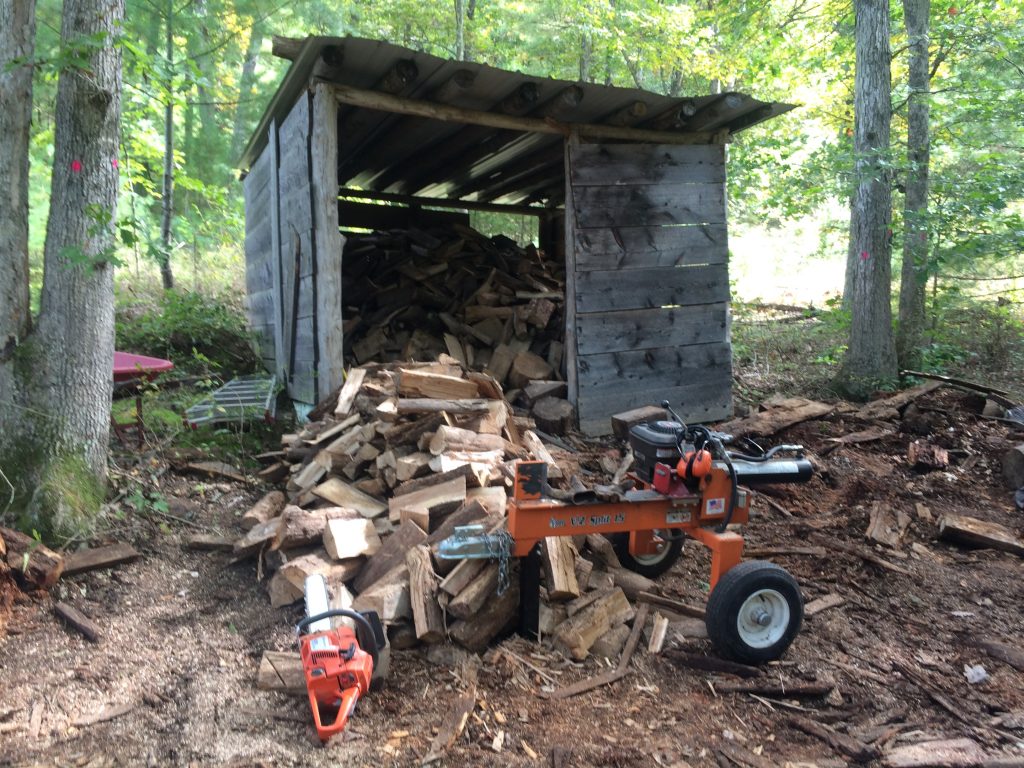
This season’s supply of split firewood stashed in the old woodshed, which is due to be replaced in 2020
Public Lands: Public good, public love
Someone named this September “Public Lands Month,” and while I have no idea who did this, or why they did it, I’ll take it nonetheless. Because like the vast majority of Americans, I totally, completely, absolutely love public land. Our public parks, forests, monuments, recreation areas, and wildlife management areas are one of the greatest acts of government in the history of human governments.
As a wilderness hunter, trapper, and fisherman, I truly love the idea of public land, and I love the land itself. No other place provides the lonesome opportunities to solo hunt for a huge bear or buck, either of which may have never seen a man before, or to take a fisher and a pine marten in a bodygripper or on a crossing log drowning rig, than public land.
If you want a representation of what is best and most symbolic of America, look to our public lands. They best capture the grandeur of America’s open frontier, the anvil upon which our tough national character was hammered and wrought. It was on the American frontier that Yankee ingenuity, self-reliance, and an indomitable hunger for individual freedom and liberty was born. And yes, while it was the Indian who reluctantly released his land to us, it was also the Indian who taught us the land’s value, so that we might not squander it, using it cheaply, profligately, and indiscriminately. Public lands are the antidote to our natural inclination to use land the same way we use everything else within our reach.
Some armchair conservatives argue that our public land is a waste of resources. That it is a bottled-up missed opportunity to make even more-more money, and if only we would just blow it all up, pave it all, dam it all, cut it all right now, etc, then someone somewhere would have even more millions of dollars in his pocket, and daggone it, he really wants those extra millions on top of the millions he already has in his pocket. When all our farmland is paved, that same armchair conservative will have nowhere to grow food to feed us, and apparently he will learn to eat dollar bills (he already thinks Dollars are what we survive on, anyhow, so it’ll be an interesting test of reality meeting theory).
But the truth is it’s mentally sick to talk about how much money you can get for selling your mother, or for selling your soul, which is what our land is, take your pick. Hunger for more money than a man knows what to do with, notwithstanding. But some things are just not worth valuing with money, and no number of payments of thirty pieces of silver will ever, ever amount to anything in comparison to what is actually in hand, our public land.
Others complain that public land is communism, but what do they say about the old English and New England commons, where villagers pastured their collected cows? Were our forebears who fought at Bunker Hill fighting for communism? You know they weren’t. Sometimes sharing isn’t a bad thing, and sharing some land is probably one of the best things. If Yosemite or Sequoia National Parks were privately owned, no one from the public would be there, right?
Americans are fortunate to have in their hand millions of acres of public land that they can access, from Maine to Alaska to Hawaii and everywhere in between. Little township and county squirrel parks, big state forests and parks, and vast national parks like the Appalachian Trail and Acadia are all magical experiences available only because they are public.
It is true that LaVoy Finicum was murdered in cold blood by out of control public employees over a legitimate debate with tyrannical, unaccountable public land managers in Oregon. But that is not the fault of the public grazing land there, any more than a murder can be blamed on the gun and not the man who pulled its trigger. We need to hold accountable those who screwed over Finicum and those who murdered him, not blame the land on which it all happened. Despite some failings by public land managers, of which Finicum’s murder is a great and sad example, public land remains one of the very few things that government actually does well and right almost all of the time. Corrective action is just one new administration away, as selected by the voters.
If you want to see untrammeled natural beauty for campers and hikers, or if you want to experience bountiful hunting lands for an afternoon or a week, then look to the public lands near you or far away from you. Everything else – nearly 100% of private lands – is either dead, dying, or slated for eventual execution at the hands of development.
We need a lot more public land in America. We need more to love in life, and nothing compares to loving a whole mountain range, a river, a field or a forest. It will love you back with nurture and sustenance, too.
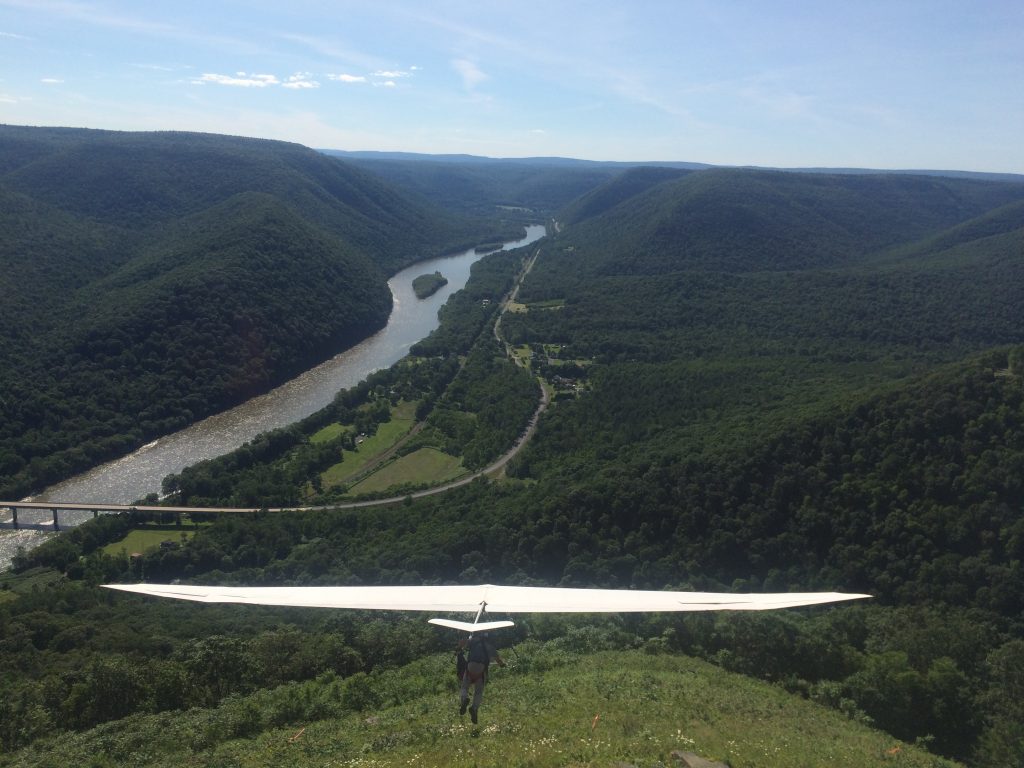
Hang glider leaps off of Hyner View State Park, surrounded by a couple million acres of Pennsylvania state forest and state parks

Down below Hyner View State Park is the Renova (Renovo) municipal park, with some historical artifacts from past freedom-ensuring conflicts, reminding the next generations of the sacrifices made so they can enjoy iPhones and Starbucks
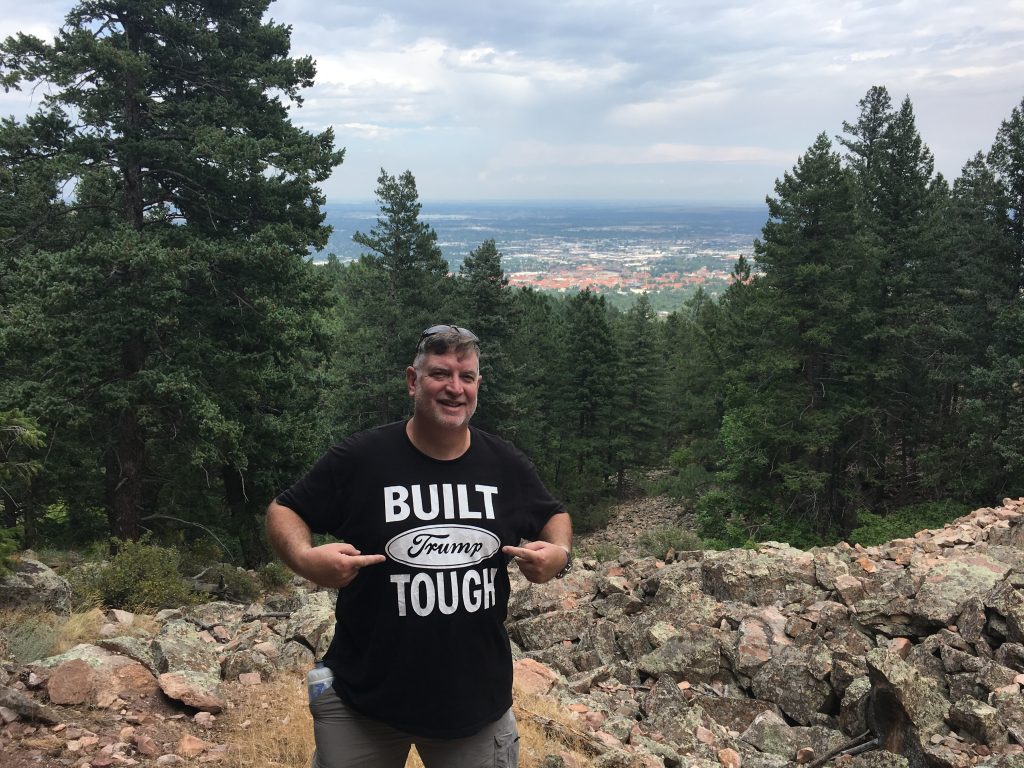
Yours truly standing high up in the Flatirons above super-liberal Boulder, Colorado, in the background, demonstrating “Trump Over Boulder” in case any hikers had missed the shirt. None had missed its presence there, by the way. Lots of public land here, enough for everyone to share, even Donald Trump! (and yes, there are a lot of boulders here in the photo).
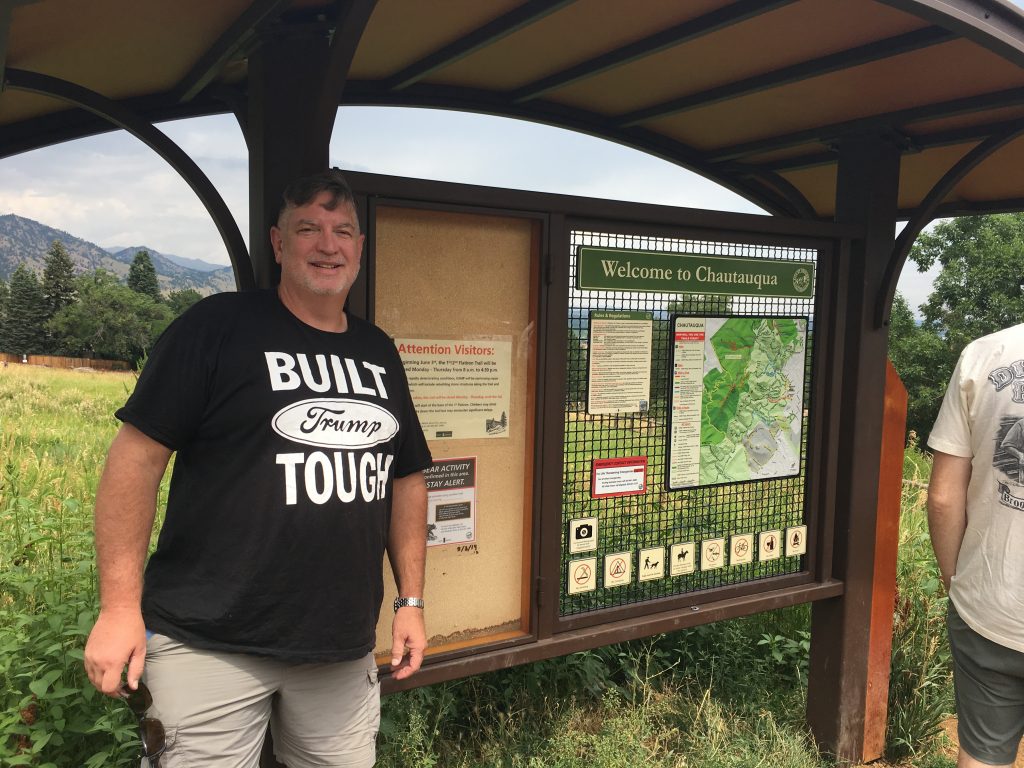
The author malingering around the Boulder, Colorado Chautauqua kiosk, silently taunting the invasive liberals gathered and passing through there. And in fact, the Trump shirt earned many double and triple-takes from fellow hikers, unused to experiencing diversity of thought. I did not bite those people, though I was tempted. Great public lands experience!
PA wildlife: damned if we do, damned if we don’t
Like every other state in the Union, Pennsylvania protects, conserves, and manages its wildlife through a combination of user-pays fees like hunting and fishing licenses on the one hand, and a helping of federal funding collected from user-self-imposed federal taxes on hunting and fishing equipment like boats, guns, ammunition, fishing rods etc on the other hand (the same people who buy the hunting and fishing licenses).
Yes, 100% of the nation’s citizenry benefits from the self-imposed taxes and fees paid by just 1% of the population: the hunters, trappers, and fishermen. Yes, you read that right: just 1% of the population is carrying 100% of the public burden.
And yes, as you are correctly about to say out loud, you and I will not see this bizarre and totally unsustainable arrangement in any other area of public policy. Not in roads, not in schools, not in airports, not in museums, not in anything else official and run for public benefit. And so, yes, it is a fact that wildlife agencies across America are perennially underfunded, and have been for so long that it’s now accepted as the way America does its wildlife business. Here in Pennsylvania, despite endless rising costs and endlessly more expensive public pensions, both houses of the PA legislature have long blocked the PA Game Commission from getting a hunting license increase in decades. So the PGC is even more behind the financial Eight Ball than most other state wildlife agencies. Hunters and wildlife managers in other states look at Pennsylvania and shake their heads. It doesn’t have to be this way, but it is.
Despite the obvious imbalance and weakness inherent in such a unique and faulty funding arrangement, for fifty years this approach worked pretty well, nationally and in Pennsylvania, with some states occasionally putting new money into holes that opened up in the regular wildlife funding support. Those states with significantly increasing human populations tend to be forced into dealing with inevitable wildlife-human conflicts more than other states, and when Mr. and Mrs. America are increasingly hitting deer with their cars, you can bet that they will demand their home state do something about it. So more money is found.
So along comes the Pennsylvania Auditor General, to investigate the management and expenditure of money at the PGC. And why not, right? The PGC is a public agency, and hunting license revenue is a public trust. So sure, go ahead, look into it, audit the agency. And so it was done, and some interesting things emerged just a bit over a week ago.
In the “Atta boy” column is the fact that there appears to be no corruption, graft, or misuse of scarce sportsmen’s dollars at the PGC. By all accounts, PGC is transparent and well run. Given how much the sportsmen are always scrutinizing the agency, we all figured as much. But it is nice to have our beliefs and trust confirmed like this. We love the PGC even more today than before the audit.
In the “Aww shucks” column is the revelation that PGC staff do not immediately deposit oil and gas royalty checks when they are received, nor does the PGC ascertain for itself if those royalty payments are accurate in the first place, instead trusting the oil and gas companies to do what is right on their own. Hmmmm….This is a potential problem area, and we are all glad the auditors found it. Anyone who knows the PGC can bet money on the fact that PGC staff are right now doing all of this payment followup with a vengeance. Look out, oil and gas companies!
But then there is the big weird issue, the biggest issue of all, where the auditors “discover” that the PGC is sitting on $72 million in the bank. And accordingly, the auditors immediately and erroneously ascribe this to bad money management. After all, they say, public money is meant to be spent. “If you got ’em, smoke ’em,” goes the ancient and totally irresponsible government approach to managing public dollars. After all, under normal budgeting culture, agencies that do not spend the money budgeted to them risk losing those dollars in the next budget cycle. Failure to spend money is correlated with a failure to implement an agency’s mission, and for senior agency managers, there is the usual ego factor; the bigger the budget, the bigger the…you know. This is the old approach to managing government funds, and it is wrong, and it certainly does not fit the PGC’s reality or targeted way of doing business.
Let’s ask you a question: If you knew your family was going to be receiving less and less money going forward, and yet your family costs would be held steady, wouldn’t you begin to bank any extra money you had, in preparation for lean times ahead? If your family is responsible, then yes, this is what you do, it is what we all do. And it is what the PGC has done, thankfully.
But as a result of the audit, this single fact is being used to beat on the agency, to coerce the PGC to adopt unsustainable policies and irresponsible money management, despite the agency sailing through ever less sustainable funding waters every day. Seems like now every elected official and every Monday morning quarterback sportsman has some variation on the foolish theme that PGC has more money than it knows what to do with. Wrong!
So the real outcome of the audit is that Pennsylvania wildlife are damned either way, because the PGC is the useful straw man whipping boy for every aspiring demagogue in Pennsylvania politics. No matter what the PGC does, our wildlife resources are going to suffer. If PGC carefully, frugally husbands its limited resources, preparing for rainy days and needy wildlife, then the agency’s critics say the agency is miserly and hoarding, and they seek to punish the agency. And on the other hand, if the PGC immediately spends every dime it has, and has no money left over to deal with yet more unfunded mandates like Chronic Wasting Disease, then critics say the agency is wasteful and ineffective, and they seek to punish the agency.
And either way, the net result is the PGC’s critics damn and condemn our wildlife. Because that is the true result of all this second-guessing and monkeying about with the PGC budget and funding streams. Plenty of elected officials use their criticism of the PGC to artificially burnish their “good government” credentials, when in fact they are demanding the worst sort of government, and a total disservice to the sportsmen and wildlife everyone enjoys.
Many years ago, sportsmen were organized enough to react strongly to political demagogues who threatened our wildlife resource (and PA’s $1.6 billion annual hunting economy) with their petty politics. This latest iteration of the politics of wildlife management indicates that we need to get back to the old days, where sportsmen were unified and forceful, even vengeful, in their expectation that their elected officials would not politicize or hurt our commonly held wildlife resource.














